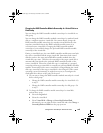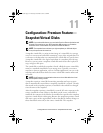
144 Configuration: Disk Groups and Virtual Disks
You can also use the Command Line Interface (CLI) on both Windows and
Linux hosts to add free capacity to a disk group. See the CLI Guide for more
information.
After the capacity expansion is completed, additional free capacity is available
in the disk group for creation of new virtual disks or expansion of existing
virtual disks.
Virtual Disk Expansion
Virtual disk expansion is a dynamic modification operation that increases the
capacity of standard virtual disks.
NOTE: Snapshot repository virtual disks can be expanded from the CLI or from
MDSM. All other virtual disk types are expandable only from the CLI.
If you receive a warning that the snapshot repository virtual disk is becoming
full, you may expand the snapshot repository virtual disk from MDSM. See
"Snapshot Repository Capacity" on page 163 for step-by-step instructions.
Using Free Capacity
You can increase the capacity of a virtual disk using the free capacity on the
disk group of the standard virtual disk or the snapshot repository virtual disk.
The Free Capacity node, shown in the Logical pane, is a contiguous region of
unassigned capacity on a defined disk group. When increasing virtual disk
capacity, some or all of the free capacity might be used to achieve the required
final capacity. Data on the selected virtual disk remains accessible while the
process for increasing virtual disk capacity is in progress.
Using Unconfigured Capacity
You can increase the capacity of a standard virtual disk or a snapshot
repository virtual disk using the unconfigured capacity when no free capacity
exists on a disk group. An increase is achieved by adding unconfigured
capacity, in the form of unassigned physical disks, to the disk group of the
standard virtual disk or the snapshot repository virtual disk. See "Disk Group
Expansion" on page 143.
For more information, see the PowerVault Modular Disk Storage Manager
online help topics.
book.book Page 144 Thursday, December 9, 2010 3:20 PM


















